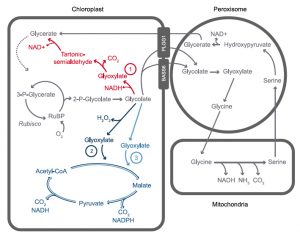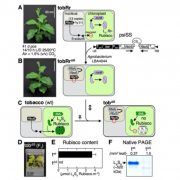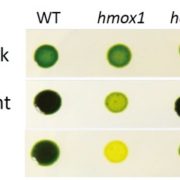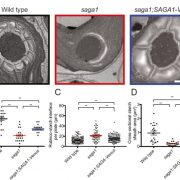Synthetic glycolate metabolism pathways stimulate crop growth and productivity in the field ($) (Science)
 Rubisco uses CO2 from the air to carboxylate its substrate RuBP, resulting in an increase in fixed carbon. However, rubisco can also oxygenate RuBP and this leads to the production of glycolate. Plants must invest energy in recycling this toxic by-product in a process called photorespiration, resulting in a loss of fixed carbon. South et al attempted to improve photosynthesis and boost yields by recycling glycolate through more efficient pathways. They engineered three photorespiratory bypasses independently into tobacco, and performed glasshouse and field trials on the transgenic plants. All three pathways increased total biomass to varying degrees. The pathway conferring the biggest gain in biomass consisted of an algal glycolate dehydrogenase and a malate synthase from squash. This bypass showed a further enhancement in biomass (40% higher than wild type) when coupled with RNAi suppression of a chloroplast glycolate transporter (PLGG1), which reduced the capacity of glycolate to enter the native photorespiratory pathway. The authors also observed that these plants had an improved photosynthetic rate, and concluded that this was a result of CO2 release inside the chloroplast as a consequence of the introduced pathway. Having demonstrated the power of this approach in tobacco, engineering these pathways into crop species is now hotly anticipated. (Summary by Mike Page) Science 10.1126/science.aat9077
Rubisco uses CO2 from the air to carboxylate its substrate RuBP, resulting in an increase in fixed carbon. However, rubisco can also oxygenate RuBP and this leads to the production of glycolate. Plants must invest energy in recycling this toxic by-product in a process called photorespiration, resulting in a loss of fixed carbon. South et al attempted to improve photosynthesis and boost yields by recycling glycolate through more efficient pathways. They engineered three photorespiratory bypasses independently into tobacco, and performed glasshouse and field trials on the transgenic plants. All three pathways increased total biomass to varying degrees. The pathway conferring the biggest gain in biomass consisted of an algal glycolate dehydrogenase and a malate synthase from squash. This bypass showed a further enhancement in biomass (40% higher than wild type) when coupled with RNAi suppression of a chloroplast glycolate transporter (PLGG1), which reduced the capacity of glycolate to enter the native photorespiratory pathway. The authors also observed that these plants had an improved photosynthetic rate, and concluded that this was a result of CO2 release inside the chloroplast as a consequence of the introduced pathway. Having demonstrated the power of this approach in tobacco, engineering these pathways into crop species is now hotly anticipated. (Summary by Mike Page) Science 10.1126/science.aat9077









